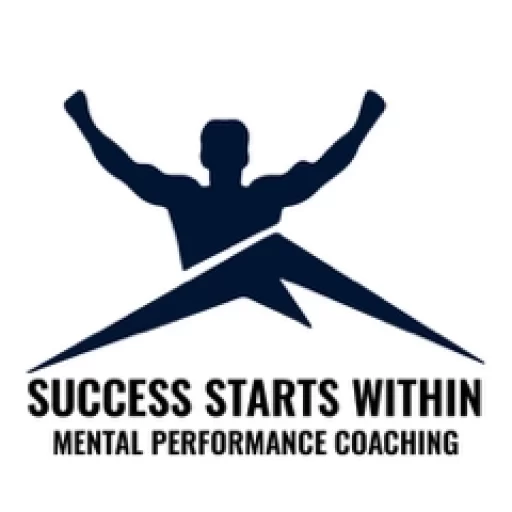Think about the last game you played. What was on your mind as the game began?
Were you thinking about how excited you were to play and thinking about all the success you were about to have?
Or were you worried about making mistakes and embarrassing yourself?
When you play with the fear of failure, the latter will be on your mind. As you fear mistakes, it’s natural to think about the possibility of making mistakes and worry about what will happen if you play poorly.
This type of thinking only strengthens fear and increases the chances of making mistakes. Meaning, your thinking creates the very thing you’re afraid of.
Knowing the impact your thoughts have on your performance, we want to make sure your mind is helping you succeed instead of holding you back. Something the mental training tool of visualization will help us do.
Fear of Failure Explained
Fear of failure in sports refers to the mindset you have when you are scared of making mistakes.
This fear is strong. It’s not simply the thought of, I’d like to not make any mistakes. It’s the thought of, I can’t make any mistakes!!
Fear of failure involves a deep seeded aversion to making mistakes. It is driven by the thought of all the different negative consequences that stem from playing poorly.
Some of these consequences include getting benched, getting yelled at by your coach, having your teammates upset with you, letting your parents down, your stats dropping, and so on.
All in all, fear of failure is about wanting to avoid making mistakes due to the fear you have surrounding what will happen if you do make mistakes.
It is this need to avoid where we see fear wreak havoc on your game.
Avoiding The Mistakes You See in Your Mind
When I played baseball, I dealt with a lot of fear. So much fear, in fact, that it led to intense performance anxiety before and during games.
I found myself playing timid and sometimes even wishing to be benched so I could avoid any potential mistakes and the feelings of embarrassment I knew would follow.
As fear of failure overtook me, so did thoughts of messing up. Before games, all I could think about were the many mistakes I may make and the consequences they would lead to.
Because my mind was full of thoughts about failing, I naturally seeked to avoid having them come true. This is what led to timid play and avoidance behaviors.
The desire to avoid mistakes is the main way fear of failure hurts athletic performance. Once the thought of failure is on the mind, it’s natural for us to play in a safe way. However, playing in a safe way seldom leads to peak performance.
In fact, playing in a safe way can actually increase the chances of making mistakes.
For myself, as I thought about not wanting to make mistakes in the field, I grew scared of the ball being hit to me. This type of thinking distracted me. I wasn’t ready for the ball, and when it was hit to me, my reactions were delayed.
Another example of fear leading to more mistakes is during a basketball game. I have worked with many basketball players who struggle with the fear of failure. This fear leads to them hesitating.
When the ball is passed to them, instead of quickly taking the shot, they hesitate. This brief second of hesitation allows the defense to close in and makes the shot more difficult.
All of this avoiding stems from a mind focused on failure. But what if we could change what our minds see? What if, instead of seeing failure, we were able to imagine ourselves playing well?
The Role of Visualization in Managing Fear of Failure
As we think about what we don’t want to have happen, images of failing form in our mind.
I like to use the analogy of there being a big tv screen hanging over the field or court. On that screen videos are played of you messing up and failing. Would you want to watch those videos before you play, or would you look away?
While there luckily isn’t a giant tv with videos of you failing playing on it, if you are afraid of making mistakes, those videos will be playing out in your mind.
They may be memories from past games, or imagined futures that could happen in the upcoming game.
Either way, you are seeing yourself fail.
When this used to happen to me, my confidence plummeted. The same has happened to all the athletes I have worked with in mental performance coaching who’ve equally dealt with fear.
As we think about not wanting to mess up, scenes of messing up form in our mind. The more we imagine failing and messing up, the lower our confidence drops.
This is why visualization helps so much with fear of failure.
Visualization is the act of imagining yourself doing something. You create a scene in your mind and live it out.
Without knowing it, you are performing a negative visualization as you think about not wanting to fail.
We want to deliberately use visualization to fill your mind with scenes of you succeeding. Scenes of you playing the way you want instead of imagining yourself playing the way you desperately want to avoid.
In addition to using visualization to see yourself succeed, we can also use a visualization exercise to relax your mind and body.
When fear takes over, anxiety is quick to follow. Anxiety that creates tension and stress in the mind and body.
We can use visualization to calm your mind and body. The calmer you are, the more relaxed you will be able to play. When you’re calm and relaxed, this increases your chances of succeeding. If you succeed, fear lowers for the future.
So the two visualization exercises I have outlined below explain how you can visualize to build confidence, along with how you can visualize to relax the mind and body. Both of which work to reduce fear of failure during a game.
Visualization for Confidence
The first visualization exercise is the one that will replace the scene of you failing with scenes of you playing well.
Confidence in sports is all about you believing you can go out there and succeed. You need to have trust, both in yourself and your skills. Trust that allows you to let go and play freely.
This type of confidence is quick to follow good games. Since the better you play, the more likely it is you’ll have belief that you can go out there and play well again.
But what happens if you haven’t been playing well recently? What happens if your mind is full of all those negative thoughts about you messing up…what then?
That’s when we use visualization.
We need to ensure the scenes being created in your mind are of you playing well. What you can do is visualize yourself succeeding during the game, before the game even begins.
We want to break this down into two different parts: visualization as part of a pregame routine, and visualization you do right as the game is starting (or even during the game).
Using Visualization Pregame
This will be a more structured visualization. Since we know your mind will be full of negative and fearful thoughts, you want to provide yourself with a set period where you will deliberately imagine yourself playing well.
Here’s the way this will work:
- Find a quiet location and get into a comfortable seated or lying position.
- Close your eyes and take a few deep breaths to center yourself and calm your mind.
- Imagine a scene from the upcoming game. Make the scene as real as possible for yourself.
- Narrate the scene to yourself. As you imagine the scene of you playing, talk yourself through what you want to see. This is important because, since you’ve been playing with fear, it may be difficult to visualize what you want to see.
- Repeat the process for different situations within the game.
Using Visualization Right Before the Game/Start of the Game
After you’ve gone through the visualization exercise from above, your mind will be primed with visions of you succeeding. You want to hold on to those thoughts.
If you’ve been playing with fear for a while, it will be natural for thoughts of failing to return. The way to counteract such thoughts is by continuing to fill your mind with scenes of you playing well.
If the game is about to begin, or if it has already started, you may not be able to close your eyes and visualize formally like with the pregame visualization. Instead, this visualization will take the form of an open-eye visualization.
What you want to do is continue thinking about playing well. Keep your mind full of visions and thoughts of you succeeding. If you can do that, you will keep the negative thoughts of you failing at bay.
Visualization for Relaxation
The first visualization exercise was all about confidence. Getting you to imagine yourself playing well, instead of having your mind full of thoughts centered around you failing.
Now we want to use visualization to counteract the tension and stress fear creates.
Fear of failure feeds into sports performance anxiety. The fear you feel will drive worries and feelings of stress.
Unfortunately, the anxiety that fear drives only increases the chances of you performing poorly and causing the very thing you’re afraid of to happen.
We need a way to calm the mind and relax the body when tension and stress take over. That is what this second visualization exercise will help you do.
Much like the first exercise, it is broken into two parts.
Part One
The goal with part one of this visualization is to build a connection between a scene and a feeling of relaxation.
The way it works is you choose a relaxing scene (walking on the beach, for example). Then you set aside five minutes a day to visualize that scene. Put yourself into the environment and make it real.
As you visualize the relaxing scene, work to feel as calm and relaxed as you would feel if you were really there.
You want to do this every day. The more you visualize the relaxing scene and feel relaxed, the stronger the connection between the scene and a feeling of relaxation will grow.
Part Two
By completing part one, you will be building a connection between a certain scene and a feeling of relaxation. For part two, you will use that connection to manage any fear or anxiety you feel.
Right before the game begins, think of your relaxing scene. You don’t need to close your eyes, but you can if you have the opportunity.
If you are stretching or warming up, think of the scene. Feel the relaxation that follows.
Right as the game begins, put yourself back in that scene by imagining it.
This will help calm your mind and body, instead of having the stress and fear control you.
Final Thoughts
Fear of failure is a common mental game challenge athletes face. When there is fear present within your game, it’s natural to play to avoid.
As you play to avoid, you may hold yourself back, play too safe, and overall perform below your potential.
One of the main ways fear of failure hurts you is due to the thoughts of failure that fill your mind, along with the stress and tension those thoughts drive.
To counteract these fearful thoughts, you can use two visualization exercises: one for confidence and one for relaxation.
By incorporating both into your game, you will work to build trust, calm your mind, and reduce the negative impact fear has on your game.
Thank you for reading and I wish you the best of success in all that you do.





